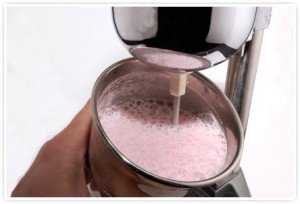>
Proteins appear to be basic material for cell construction. The name ‘proteins’ (from Greek Protos – main, the most important) reflect the initial idea of this substance class very precisely.
Proteins
– appear to be the main structural cell component;
– are used for development, ‘reconstruction’ and preservation of body tissues;
– appear to be an energy source.
An actively training athlete should take 1-2 gr of proteins per pound of body weight a day. The processes of muscle recovery and growth take place during two-three after-training days; that’s why it’s extremely important to provide uninterrupted and even delivery of amino acids to muscle cells.
You shouldn’t forget to take a lot of proteins (quickly-assimilated serum proteins) within 1 hour right after a training session: a protein-carbohydrate cocktail (see the section ‘Energy drinks’) – within the first half an hour and a protein cocktail – in 40-60 minutes.
There are different types of proteinic supplements: milk, meat, vegetable, egg, etc. But the two main ones are the following:
– whey
– casein
Each protein type possesses its own peculiar features. When scientists tried to compare influence of whey protein and casein on synthesis of proteins of our organism they found out that casein was assimilated very slowly, gradually releasing amino acids into blood. It influences protein synthesis to a little extent but significantly slows down the process of its decomposition. That’s why it’s an ideal protein type to take before going to sleep because it will protect your muscles from catabolism during this time.
Whey protein releases amino acids rather quickly and influences protein synthesis quite significantly. Unfortunately its effect lasts not long (for about an hour); besides it, sudden rise of protein synthesis leads also to increase of catabolic reactions because our organism is very dynamic and launches the process of protein decomposition parallel to its synthesis. That’s why whey protein will be very useful right after a training session or in the morning when there’s a necessity to raise your body amino acid level maximum quickly.
Whey protein is produced by filtration of fats, lactose and other lactic components by means of certain methods. Here are the main methods:
ULTRAFILTRATION: liquid whey is being run under high pressure through membrane holes. Their diameter lets through water, microelements, fats and lactose while protein fractions settle on the membrane and are being collected.
MICROFILTRATION: it’s a repeated filtration through a membrane at a lower temperature that allows getting protein that’s even more refined from fat admixtures.
ION EXCHANGE: charged ions are being run through liquid whey. The ions connect only with protein molecules and by this they separate them from other particles. This method allows getting almost pure whey protein though ions are able to bind far from all protein fractions; so a part of useful fractions is lost.
CHROMATOGRAPHY: this expensive technology is used in medicine and is destined for separation of certain fractions of whey protein (for example, lactoferrin).
HYDROLYSIS: large chains of protein molecules are decomposed into smaller fragments named peptides; the rate of their assimilation is very fast. Decomposition is conducted by means of a certain chemical reaction.
Biological value of proteins
Biological value of one or another protein is determined by the similarity degree of its amino acid structure and the structure of a particular protein of our organism. At first it was found out that whole eggs possess the highest biological value: their value degree was marked with figure 100. Afterwards when scientists manage to get whey isolate they discovered that this protein possesses even higher biologic value: it lies between 105 and 154 units. The table below presents biological value of major protein types.
| Protein | Biological value |
| whey isolate | 110-159 |
| Whey concentrate | 104 |
| Whole egg | 100 |
| Cow milk | 91 |
| Egg white | 88 |
| Fish | 83 |
| Beef | 80 |
| Chicken | 79 |
| Casein | 77 |
| Soya | 74 |
| Rice | 59 |
| Cereal products | 54 |
| Legume plants | 49 |
Intake form
Proteins are produced in the form of powders and are used mostly in as protein cocktails. In order to prepare a protein cocktail you need to use water, low-fat milk or juice. It’s prohibited to use hot liquid because proteins denaturate and the rate of their assimilation decreases greatly at high temperatures. Theoretically, the ratio powder/liquid is not important but in practice usually 250-400 milliliters of liquid is the best amount to make one protein cocktail (30-40gr of proteins). The most convenient way to make cocktails is to use mixers or hand shakers. Prepared protein cocktails should be kept for no longer than 1-2 hours.
It’s recommended to split protein intake into even portions to be taken throughout a day. At the same time, try to get the majority of proteins from natural high-protein food products (dairy products, eggs, low-fat beef and pork, chicken breasts, turkey, low-fat fish, etc.); protein cocktails are to be taken separately: between main meals or together with low-protein high-carb food products.
source:gymper.com
Tags: Protein
This entry was posted
on Monday, May 24th, 2010 at 7:57 am and is filed under HEALTH PUBLICATIONS, NUTRITION.
You can follow any responses to this entry through the RSS 2.0 feed.
You can leave a response, or trackback from your own site.


